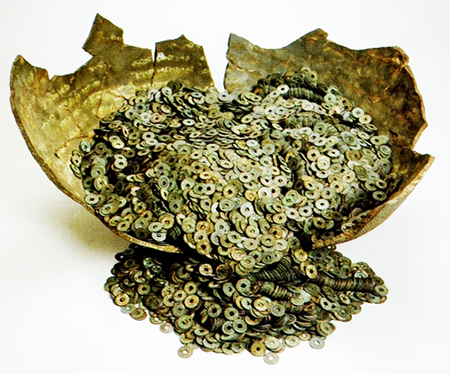
1968年になって志苔館下の国道278号線の拡幅工事で、3つの大甕に入れられた膨大な量の古銭が見つかった。古銭はその相当部分が出土後に盗難にあったとされるけれど、残った枚数だけでも37万4千枚にものぼり、これは日本国内で1ヶ所からまとまって発見された古銭としては過去最多の記録的な量。この出土古銭について科学的な解析が進められた。
容器の大甕は室町時代前期から中期の製造で2つは福井県の越前古窯、もう1つは石川県能登半島の珠洲窯ということ。そしてこの1文銭は室町時代の貨幣価値では現在のおおむね100円に相当するとされるので、37,400,000円相当となる。盗難された分を加えて考えれば1億円程度が埋蔵されていたか。
そのほとんどは中国からの渡来銭で全体の85%という。貨幣としての流通機能としては、渡来であろうが国産であろうが出自は問わずに流通していただろう。現代でもわれわれはいちいちの個体の「製造年代」を気にしたりはしないで流通させている。埋蔵された時期はおおむね14世紀の段階でと年代特定もされているとのこと。発見された古銭は国指定重要文化財として市立函館博物館に展示されている。
こうした古銭の流通を考えれば、当然、他の地域との「交易」決済手段が考えられる。当時の北海道島内部で、そうした古銭が大きく流通するという経済発展は考えられない。主要な流通はやはり大甕の生産地域・北陸地域との「北前交易」が考えられる。昨日まで触れたように、志苔館側のコンブと地域アイヌ社会との交易品である鮭が北海道島側の交易産品で、北陸側からはさまざまな生活用品、コメなどの食料品などが考えられる。一方、アイヌ社会は前述のように鮭の交易もあっただろうが、道南地域の地場のアイヌの人びとはコンブ漁などの使役労働力として賃金労働に従事したことが推測される。
さらに志苔館周辺で1456年に勃発した「コシャマインの戦い」の発端になったといわれるアイヌの少年と、和人の鍛冶屋との間での口論・殺傷事件が想起される。鍛冶屋は不満を言ったアイヌの有力者の子どもを問答無用と刺殺してしまったのだという。
この事件はアイヌの少年が発注した小刀(マキリ)の品質と価格を巡って発生した。ということはアイヌの社会にも一定の貨幣経済の浸透があったと言える。要するに「高い、安い」という価値判断が常態化していたことになる。もちろん和人側がほぼ価格決定を独占していて、アイヌの側としては和人の「言いなり」で価格決定される経済実態があったのだろう。塩鮭などは生産流通をアイヌが押さえていただろうけれど、圧倒的多数の生活用具の流通・価格決定は和人が独占していた。
こうした背景状況のなかで、道南十二館の併存的権力状況が「コシャマインの戦い」によって再編成され道南地域での松前藩支配体制が固まり、近世までの北海道島の政治権力状況が出現していく。
English version ⬇
A large jar of old coins, evidence of 15th century trade with the northern frontier / Shinoridate, Hakodate, Hokkaido, Japan
The large jar of old coins excavated from the site reveals the trade with Hokuriku and the actual monetary society of medieval Hokkaido Island. And eventually to the Battle of Koshamain. The battle of Koshamain.
In 1968, during the widening of Route 278 under Shikokan, an enormous amount of old coins were found in three large jars. Although a significant portion of the coins were reportedly stolen after they were unearthed, the number of coins remaining alone amounted to 374,000, which is the largest number ever found in Japan in one location in one place. Scientific analysis of the unearthed coins was conducted.
Two of the large jars were made in the early to mid Muromachi period, one at the Echizen Kiln in Fukui Prefecture and the other at the Suzu Kiln on the Noto Peninsula in Ishikawa Prefecture. And since this 1-bun sen is said to be equivalent to roughly 100 yen today in terms of Muromachi period currency value, it is worth 37,400,000 yen. If the stolen coins are added to the total, the total amount of 100 million yen is estimated to have been buried in the kiln.
Most of the coins are said to have come from China, accounting for 85% of the total. As a coin in circulation, it would have circulated regardless of its origin, whether it was imported or domestically produced. Even today, we do not pay attention to the “date of manufacture” of each individual coin. The date of the burial has been determined to be roughly in the 14th century. The discovered coins are on display at the Hakodate Museum as nationally designated important cultural properties.
Considering the circulation of such old coins, it is natural to think of “trade” with other regions as a means of settlement. It is unlikely that such a large circulation of old coins was an economic development in Hokkaido Island at that time. The main distribution is thought to have been “Hokusen trade” with the Hokuriku region, the area where large jars were produced. As mentioned yesterday, kelp from the Shikokan side and salted salmon, a product of trade with the local Ainu community, were the trade products of the Hokkaido Island side, while various daily commodities, rice and other foodstuffs from the Hokuriku side were considered. On the other hand, the Ainu society probably traded in salted salmon, as mentioned above, but it is assumed that the local Ainu people in the southern Hokkaido region engaged in wage labor as laborers, such as kelp fishermen.
In addition, we can recall the altercation and killing incident between an Ainu boy and a Japanese blacksmith, which is said to have triggered the “Battle of Koshamain,” which broke out in 1456 in the Shikokan area. The blacksmith stabbed the child of an influential Ainu leader to death without question when he complained.
This incident occurred over the quality and price of a small sword (makiri) ordered by an Ainu boy. This means that the Ainu society also had a certain degree of penetration of the monetary economy. In other words, “high price, low price” was a normalized value judgment. Of course, the Japanese had a monopoly on price determination, and the Ainu probably had an economic reality in which prices were determined at the “behest” of the Japanese. Although the Ainu probably controlled the production and distribution of salted salmon and other products, the distribution and pricing of the overwhelming majority of daily necessities were monopolized by the Japanese.
Against this backdrop, the coexisting power structure of the Twelve Provinces of Southern Hokkaido was reorganized through the “Battle of Koshamain,” which solidified the Matsumae Domain in the southern region of Hokkaido, and the political power structure of the island emerged until the early modern period.
Posted on 4月 30th, 2024 by 三木 奎吾
Filed under: 日本社会・文化研究, 歴史探訪







コメントを投稿
「※誹謗中傷や、悪意のある書き込み、営利目的などのコメントを防ぐために、投稿された全てのコメントは一時的に保留されますのでご了承ください。」
You must be logged in to post a comment.